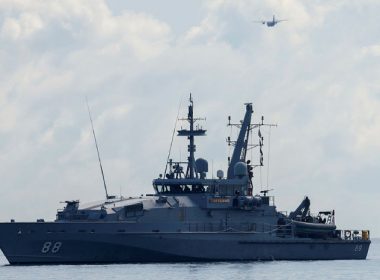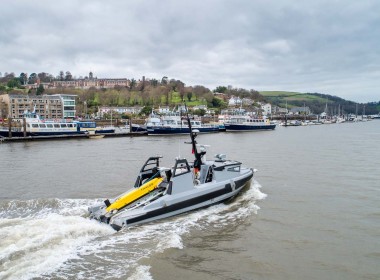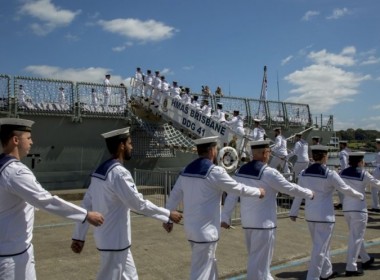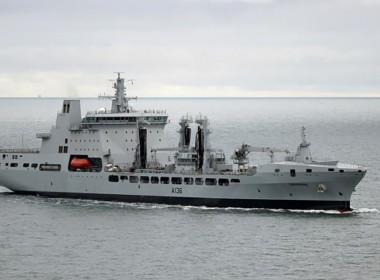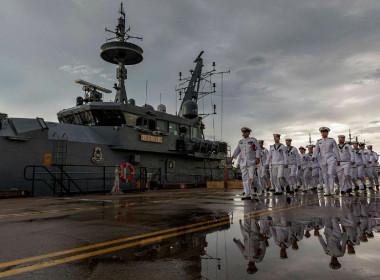OPINION | How to plug the Royal Australian Navy’s looming surface capability gap

Released 10 months after the defence strategic review (DSR), the annexed and long-awaited review of the Royal Australian Navy’s surface combatant fleet has finally brought some much-needed clarity on the RAN’s ambitions to expand and add potency to its current inventory of eight frigates and three destroyers.
To a more contingent extent, last week’s announcement also signalled the government’s willingness to back the new blueprint financially, committing $1.7 billion over the forward estimates and $11.1 billion in additional funding in the coming decade. Whether this represents sufficient puff to fill the tattered sails of naval recapitalisation and generate forward momentum is uncertain. As long as the bulk of the estimated $54 billion overall cost of the plan remains unbudgeted, the risk of being mired in future budgetary doldrums will continue to weigh over the navy’s ambitions.
A healthy dose of scepticism around big defence announcements in Australia is understandable given the mixed record of governments on delivering investment on a timescale that is strategically relevant. And the DSR was unambiguous about the urgency of the need to retool the Australian Defence Force with greater lethality across the board.
Given Australia’s island geography, any significant war in the neighbourhood would involve the navy heavily, directly or indirectly. The plan to acquire nuclear-powered and conventionally-armed attack submarines (SSNs) under the AUKUS agreement with the US and UK is already part of that equation. But submarines cannot provide a silver-bullet strategic solution on their own. Their success, as a deterrent, depends upon an integrated RAN and ADF operating as a whole.
“For the foreseeable future, the RAN’s core combat power will be generated from crewed surface combatants, leveraging new technology but with a human edge.”
Australia needs an ocean-going navy for protection against the full range of threats on, above, and below the water. If supplies are unable to flow in by sea, Australia’s economy and war effort would quickly shut down. The advance of technology has not fundamentally altered that strategic reality since 1945. In fact, our supply chain vulnerability and fuel poverty have grown significantly more acute.
The vanguard of this up-fanged surface fleet will be six new Hunter-class frigates, specialised for hunting submarines, and the three existing air warfare destroyers to be upgraded. Another six “optimally crewed” large surface vessels that are being ordered additionally hint at a rather different, hybrid navy of the future, where mass is less dependent on manpower. But for the foreseeable future, the RAN’s core combat power will be generated from crewed surface combatants, leveraging new technology but with a human edge.
Plans to acquire a further 11 general-purpose frigates from a yet-to-be decided mature design will eventually raise Australia’s frontline surface strength to 26 warships, easily surpassing the Royal Navy’s current inventory of just 19 frigates and destroyers—though this too will hopefully grow in future.
Yet, even if the RAN’s blueprint is fully funded, holds to schedule, and crews for the new ships can be found, trained and retained—a second potential bottleneck on the planned expansion—Australia’s surface combatant fleet is still certain to undergo a decline in strength in the short to medium term, with the retirement of HMAS Anzac this year and a second frigate, Arunta, in 2026. By then, we will surely know the design of their replacements, but still be several years away from acquiring them.
A looming capacity and capability gap in the surface force therefore presents a third area of risk.
“Foreign warships will ultimately answer to foreign governments, but the task of attracting them to Australia should be conceived and approached as an element of broader statecraft.”
In the submarine realm, the optimal pathway announced last year includes provision for up to four US Navy (USN) nuclear submarines and a single British boat to “rotationally deploy” out of Fleet Base West at HMAS Stirling, south of Perth, from as early as 2027, several years before the first Virginia-class SSN is transferred to Australia. This forward basing (in all but name) of US and UK submarines under SRF-West has reduced anxiety about whether we could be left under-defended until AUKUS starts to deliver nuclear hulls into Australian hands in the early 2030s.
This begs an obvious question: would a similar solution be advisable for the surface fleet’s looming shortfalls?
One possibility here would be to offer the UK access to Fleet Base West for the forward deployment of two frigates, which later this decade should replace the current, roving pair of River-class offshore patrol vessels as the UK’s main surface presence in the Indo-Pacific. The step-up to frigates will necessitate more complex logistical support than the commercial-spec OPVs, pointing to the need for a fixed base in a friendly location. The combat capability the Type 31 or Type 32 frigate will bring would be a useful adjunct to the dwindling cohort of Anzac-class frigates, maintaining a strategically aligned presence in the north-east Indian Ocean and Southeast Asia. An offer to host them from Australia would also help the Royal Navy make the case for continued forward deployment to the British government, which could change political stripes in general elections later this year.
For the US, its new Fincantieri-designed Constellation-class frigates will begin to come online from the late 2020s. These vessels are not likely to be the USN’s platform of choice for the Pacific, but there may be wider value in deploying them on periodic detachments out of Fleet Base East, in Sydney, to help cover naval engagement in the South Pacific. They could support coincident US and Australian interests there, for example helping to realise more regular access to PNG’s base at Lombrum, in Manus Island. If New Zealand joins in the Anzac-class replacement program with Australia that would help with a more proximate source of capability, but probably not when Australia needs the support of its allies and partners most.
The search for such support should not be limited to the traditional allies only. If Japan, with more frigates and destroyers at its disposal than any US ally and a reciprocal access agreement in place with Australia, can be tempted into similar forward-deployment arrangements, all the better.
As prospective host, Australia should be active in making such offers now, being accommodative where it can. Political sensitivities that have become entrenched towards the presence of foreign forces in Australia need to be balanced against the strategic urgency of our situation and a likely need to plug a short- to medium-term gap in surface combatant capacity. Foreign warships will ultimately answer to foreign governments, but the task of attracting them to Australia should be conceived and approached as an element of broader statecraft.


